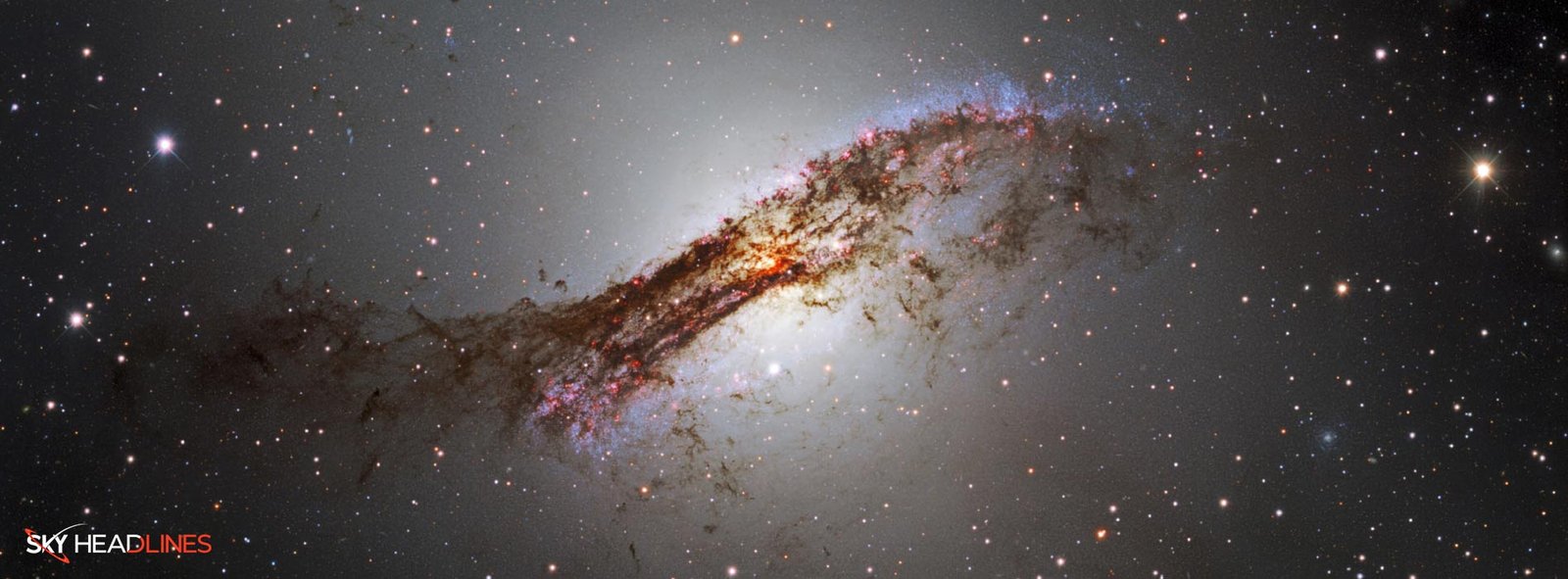Centaurus A, also known as NGC 5128, is one of the most intriguing objects in the astronomical world, offering a wealth of information and mysteries to researchers. This article delves into the various aspects of Centaurus A, exploring its characteristics, significance in astronomical research, and the mysteries it holds.
Discovery and Observation
Centaurus A was discovered in the early 19th century by British astronomer James Dunlop. Centaurus A is located around 12 million light-years away situated in the Centaurus constellation. It holds the distinction of being one of the closest radio galaxies to Earth. Over time, scientists have studied Centaurus A using different wavelengths, ranging from radio to gamma rays. This achievement has become attainable thanks to both ground-based telescopes and space observatories such as the Hubble Space Telescope and the Chandra X-ray Observatory.

Is Centaurus A visible?
Centaurus A (NGC 5128) is visible from Earth, but its visibility depends on several factors, including location, time of year, and observing conditions.
- Location: Centaurus A can be found in the southern celestial sphere within the Centaurus constellation, making it most prominently visible from the southern hemisphere and regions with lower latitudes in the northern hemisphere. Observers situated in places such as Australia, South Africa, and South America enjoy a superior vantage point for observing this galaxy.
- Time of Year: The best time to view Centaurus A also depends on its position relative to the Earth’s rotation and orbit. For observers in the southern hemisphere, the best viewing months are typically around April to July.
- Observing Conditions: Like any astronomical object, clear, dark skies away from city lights provide the best observing conditions. Light pollution significantly reduces the visibility of fainter objects like distant galaxies.
- Equipment: While Centaurus A is one of the brightest radio galaxies in the sky, its visual magnitude is around +6.8, which makes it challenging to see with the naked eye. Binoculars or a small telescope can significantly enhance your chances of observing it.
Physical Characteristics of Centaurus A
Centaurus A is a peculiar galaxy, primarily known for its massive size and the giant lobes of radio emissions extending far beyond its main structure. These lobes are evidence of the intense energy processes occurring at its core. The galaxy has a distinctive feature: a dark dust lane across its center, which is the remnant of a past collision with another galaxy. This collision is believed to have significantly altered its structure and dynamics.
How big is Centaurus A?
Its size can be considered in two main ways: its apparent size in the sky and its actual physical size.
- Apparent Size: In the night sky, as viewed from Earth, Centaurus A spans an angular diameter of about 25 arcminutes. For comparison, the full Moon in the sky has an angular diameter of about 30 arcminutes. This makes Centaurus A, a relatively large galaxy in terms of its apparent size when viewed through a telescope.
- Physical Size: In terms of its actual size, Centaurus A is a giant galaxy. The estimated length of its major axis is approximately 60,000 to 70,000 light-years, making it slightly smaller than the Milky Way, which boasts a diameter of about 100,000 light-years. However, when considering the radio lobes – vast clouds of gas expelled by the galaxy’s central black hole – the galaxy extends much further. These lobes extend over a distance of several hundred thousand light-years from the core of the galaxy, rendering Centaurus A’s entire structure, inclusive of its radio lobes, one of the most massive single entities in the observable universe.
Centaurus A stands out not only due to its impressive size but also because it qualifies as an active galaxy housing a supermassive black hole at its core. This particular black hole is the driving force behind the galaxy’s robust emissions of radio and X-rays, rendering it a focal point of considerable fascination in the realm of galactic dynamics and the study of black hole physics.
The Active Galactic Nucleus
In the core of the Centaurus A galaxy resides an active galactic nucleus (AGN) that shines with exceptional brightness, owing to the process of material accretion onto a supermassive black hole. This colossal black hole, approximately 55 million times the mass of our Sun, serves as the central powerhouse responsible for generating the galaxy’s intense high-energy emissions and the formation of its radio lobes. The AGN is also responsible for the emission of high-energy jets, which are observed extending from the core.
Is there a black hole in Centaurus A?
Yes, there is a supermassive black hole at the center of Centaurus A (NGC 5128). This black hole is a major source of interest for astronomers due to the active and energetic processes it drives within the galaxy.
Characteristics of the Black Hole in Centaurus A
- Mass: The supermassive black hole at the heart of Centaurus A is estimated to have a mass of about 55 million times that of the Sun. This estimation is derived from observations of the motions of stars and gas near the galaxy’s center.
- Activity: This black hole is classified as an active galactic nucleus (AGN). AGNs are extremely luminous regions at the centers of some galaxies, powered by material falling into a supermassive black hole. The intense gravitational pull of the black hole accretes matter from its surroundings, forming an accretion disk. Friction and other processes within this disk heat the material to extremely high temperatures, causing it to emit large amounts of radiation.
- Jets and Radio Lobes: One of the most striking features associated with the black hole in Centaurus A is the pair of enormous jets and radio lobes extending from the galaxy’s center. These jets are streams of charged particles ejected at nearly the speed of light, likely powered by the black hole’s energy. These particles interact with the interstellar medium, creating the vast lobes of radio emission that are characteristic of Centaurus A.
- Observation and Study: The black hole and its associated jets and lobes have been extensively observed across various wavelengths, including radio, X-ray, and gamma-ray. These observations help astronomers understand the behavior of supermassive black holes and the impact they have on their host galaxies.
The black hole in Centaurus A is a crucial element in understanding the dynamics of this galaxy, especially regarding its active galactic nucleus and the mechanisms driving the emission of high-energy particles and radiation.
Importance in Astrophysical Research
Centaurus A plays a pivotal role in astrophysical research. Its proximity to Earth and the scale of its jet emissions make it an ideal subject for studying phenomena related to active galaxies, such as jet formation, black hole physics, and the interaction of these jets with the interstellar medium. The galaxy functions as a research setting to explore the dynamics of galaxy mergers and how they influence the evolution of galaxies.
The Role of Galaxy Mergers
The peculiar appearance of Centaurus A is attributed to a merger between a giant elliptical galaxy and a smaller spiral galaxy. This merger is an excellent case study for understanding the complex processes involved in galactic collisions. These processes include star formation, the feeding of the central black hole, and the triggering of AGN activity. The study of such mergers helps astronomers understand the hierarchical formation of galaxies in the universe.
Radio Emissions and Jets
One of the most striking features of Centaurus A is its massive radio lobes. These lobes are composed of material ejected from the AGN at nearly the speed of light. The study of these lobes and the associated jets gives insights into the mechanisms of energy transfer from the black hole to the surrounding space. It also helps in understanding how these jets interact with and impact the galactic environment.
Multi-Wavelength Observations
Observations of Centaurus A across different wavelengths have provided a more complete understanding of its nature. Infrared observations reveal the structure of the dust lane and the star-forming regions within it. X-ray observations have uncovered details about the hot gas and the high-energy processes near the black hole. Radio observations have mapped the extensive lobes and jets, while optical observations have shed light on the galaxy’s stellar population and structure.
Unraveling the Mysteries
Despite extensive research, Centaurus A still holds many mysteries. Researchers are still actively investigating the exact mechanisms behind the formation and maintenance of its jets, the impact of the AGN on the galaxy’s evolution, and the details of the past merger event. Additionally, Centaurus A is a key object in the study of gamma-ray emissions from galaxies, an area still in its infancy.
Contribution to Cosmology
Centaurus A’s study contributes significantly to cosmology, particularly in understanding the role of AGNs and galaxy mergers in the evolution of the universe. Its proximity and the wealth of observational data available make it an invaluable resource in piecing together the history and future of galactic evolution.
Future Prospects
With the advent of new and more powerful telescopes, both on the ground and in space, the future of research on Centaurus A is promising. Future observatories such as the James Webb Space Telescope and the Square Kilometer Array are poised to deliver even more precise observations, unveiling additional mysteries hidden within this captivating galaxy.
Conclusion
Centaurus A continues to be a source of fascination and an important object of study in astronomy. Its distinctive qualities and the abundance of knowledge it provides establish it as a fundamental component in comprehending galaxies, black holes, and the intricate expanse of the cosmos. As technology advances and our understanding deepens, Centaurus A will undoubtedly continue to reveal more about the cosmos, maintaining its status as one of the most studied and enigmatic objects in the night sky.





